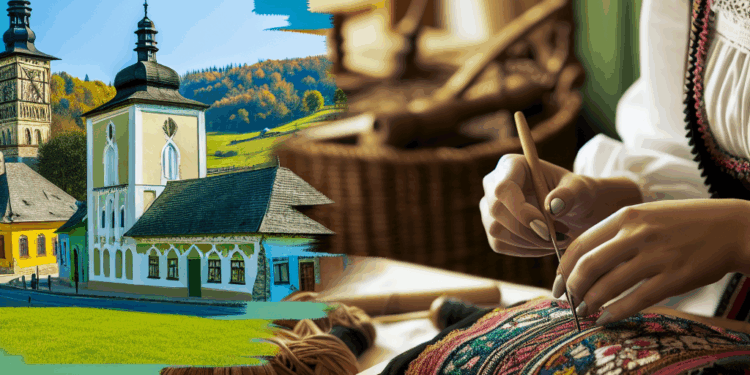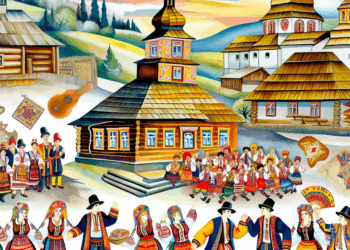Bukovyna is a unique region at the crossroads of cultures and peoples whose history goes back hundreds of years. It is a land where Ukrainian, Romanian, Jewish and Polish cultures coexist and intertwine, creating a unique and diverse cultural landscape. In this article we will take a closer look at the traditions, folk costumes, crafts, festivals, music and folklore of Bukovina, as well as the influence of different cultures on its development.
Historical context
Bukovina, located in north-western Ukraine and partly in Romania, has been known as a multi-ethnic region since antiquity. In different historical epochs it was under the influence of different states and communities. In the 18th century, the region became part of the Austrian Empire, which led to significant changes in society and culture. Later, after the collapse of the Austro-Hungarian Empire, Bukovina was divided between Romania and the USSR, which also influenced its cultural identity.
Traditions and folk costumes
The folk costumes of Bukovina are a vivid reflection of the region’s multinational heritage. The costumes of different peoples differ in style, colours and ornaments.
Ukrainian folk costumes
Ukrainian costumes of Bukovina are known for their colourful embroideries and variety of fabrics. Women’s dresses are often decorated with geometric and floral patterns embroidered in bright colours. Men’s clothing usually includes embroidered trousers and shirts, as well as leather belts.
Romanian costumes
Romanian costumes are distinguished by their peculiar cut and rich trimmings. Women in Bukovina wear skirts decorated with lace, while men wear wide trouser suits with waistcoats. The main colours of traditional Romanian costumes include red, black and white.
Jewish costumes
The Jewish community of Bukovina has also left a significant mark on the cultural mosaic of the region. Traditional Jewish costumes are characterised by refinement and simplicity. Men were characterised by black hats and long coats, while women often wore dresses decorated with lace and brightly coloured fabrics.
Polish costumes
Polish culture in Bukovina was also represented through folk costumes. Women’s costumes often included puffy skirts and embroidered blouses, while men wore traditional shirts and bonnets.
Crafts
The handicrafts of Bukovina have always occupied an important place in the cultural life of the region. Craftsmen passed their knowledge from generation to generation, which helped to preserve traditions and unique techniques.
Pottery
Pottery in Bukovina has deep roots. Masters created both utilitarian and decorative ceramics. Famous settlements such as Kohanovka and Dolynianka are famous for their unique products.
Weaving
Weaving also occupies an important place in the local crafts. Women created beautiful fabrics for folk costumes and household needs. The weaving process requires a great deal of skill and time, making each cloth truly unique.
Wood carving
Wood carving is another traditional craft characteristic of Bukovina. Masters create not only household items, but also original decorations for interiors. Famous carving masters, such as Oleksandr Savchuk, bring elements of local culture and folklore into their works.
Holidays
Bukovina’s festivals showcase the rich cultural heritage of the region and the diversity of the peoples who inhabit it.
Christmas and Easter
Christmas and Easter are the main Christian holidays celebrated by both Ukrainians and Romanians. Traditions associated with these holidays include special dishes, carols and rituals such as the consecration of Easter eggs and the preparation of kutya for dinner.
Sorochinskaya Fair
Sorochynska Fair is one of the most popular events in Bukovyna, attracting craftsmen and artisans from all over Ukraine. During the fair there are folk dances, musical performances, and an exhibition of handicrafts.
Milk Festival
The Milk Festival is a holiday that takes place annually in the village of Kozakovka. There are competitions for the best milk and cheese, as well as tastings of traditional dairy products.
Music and folklore
Music and folklore in Bukovina occupy a central place in the cultural life of the region. Local musical traditions include both instrumental and vocal components.
Instruments
Traditional musical instruments include dudkas, dulcimers and banduras. Each village has its own unique melodies and songs that reflect the lifestyle and customs of the locals.
Folklore groups
Many folklore groups and ensembles represent the music of Bukovina. For example, the ensemble “Mriya” from Chernivtsi is known for its memorable performances that emphasise the richness and diversity of local folklore.
Songs and dances
Folk songs and dances are an integral part of holidays and events. Among the most popular dances are the Hadyatsky dance and the Kolomiyka, which are available for everyone to perform.
Influence of cultures
Bukovyna is a unique cultural palette where Ukrainian, Romanian, Jewish and Polish cultures intertwine with each other. This diversity enriches the cultural heritage of the region and contributes to its development.
Ukrainian culture
Ukrainian culture in Bukovina is represented not only by the language, but also by folk songs, dances and customs. The influence of Ukrainian culture can be seen in folk costumes, folklore and traditions.
Romanian culture
Romanian culture has had a significant influence on the gastronomy and folk festivals of the region. Many Romanian dishes, such as mice and with armeni, have now become an integral part of the local cuisine.
Jewish culture
Bukovina’s Jewish community, once one of the largest in Ukraine, has shaped its unique identity by adding interesting elements to its musical and gastronomic traditions. Jewish holidays such as Hanukkah and Pesach were also celebrated in the region.
Polish culture
Polish culture has left a noticeable mark on Bukovina’s architecture and bureaucracy. Many traditions, such as baptismal celebrations and weddings, have acquired elements of Polish influence.
Conclusion
The culture of Bukovina is a reflection of its multinational heritage. Traditions, folk costumes, crafts, festivals, music and folklore show how different peoples co-exist and enrich each other. The diversity of cultures makes Bukovina unique and attractive for exploring and immersing in its multifaceted cultural world. Staying at the crossroads, Bukovina continues to preserve and develop its rich cultural history, making it not just a region, but a true cultural treasure trove of Europe.








